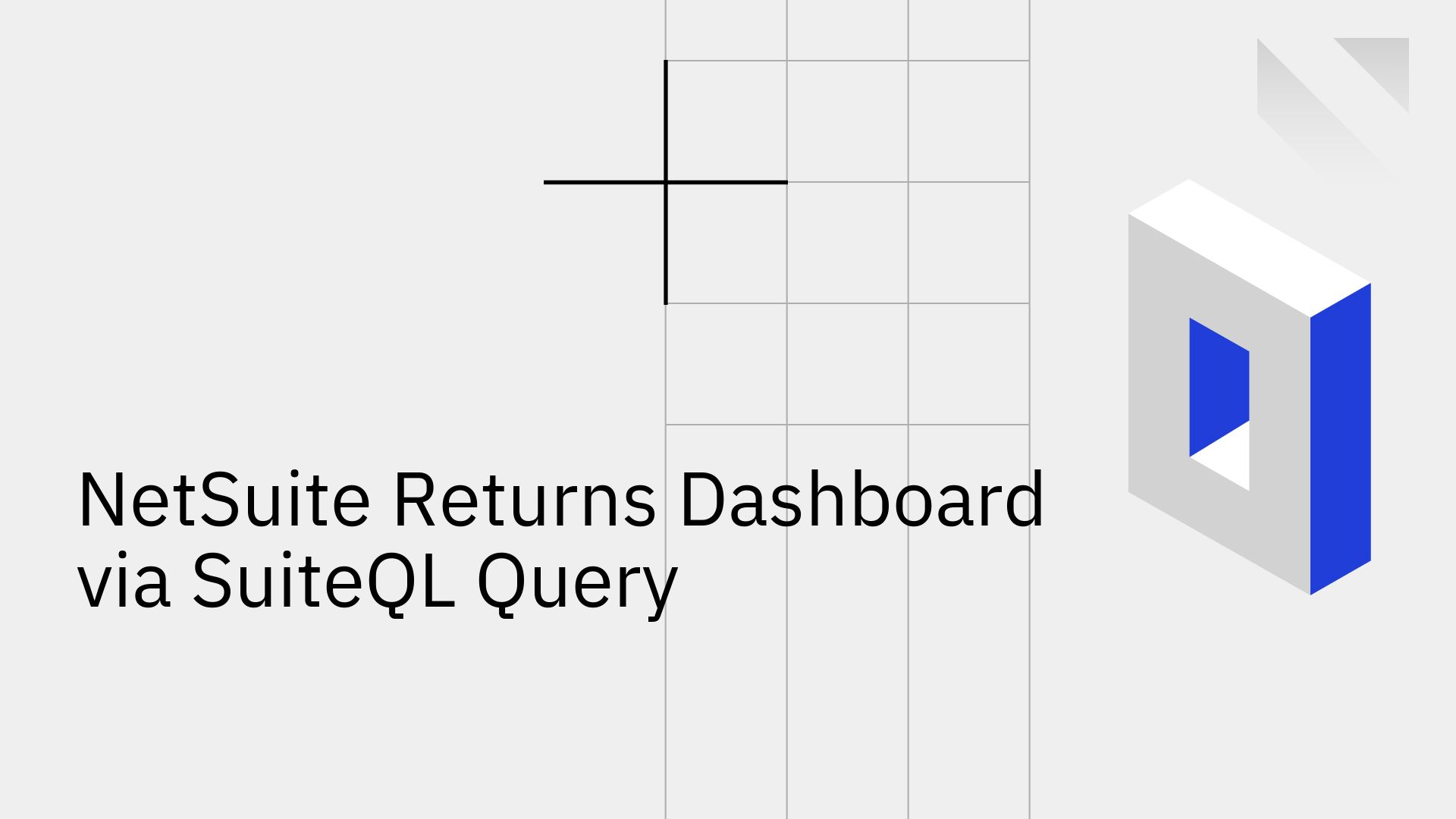
Analyzing customer returns is critical for any business, particularly wholesale distributors who need to identify patterns that could signal product quality issues, supply chain problems, or mismatched customer expectations. Understanding return patterns helps businesses make informed decisions about inventory management, vendor relationships, and customer satisfaction initiatives.
SuiteQL is NetSuite's powerful SQL interface that enables direct data querying, offering advanced query capabilities that allow you to perform complex queries with precision and efficiency. Unlike traditional saved searches that may have limitations, SuiteQL provides the flexibility needed for comprehensive returns analysis.
This article provides practical SuiteQL queries that form the foundation of a returns analysis dashboard, helping managers identify frequently returned items and their manufacturers. By leveraging these queries, businesses can transform raw return data into actionable insights that drive operational improvements.
To build effective queries, it's essential to understand the underlying data structure in NetSuite. Return data is primarily stored across three key tables: Transaction, TransactionLine, and Item, each serving a specific role in capturing return information.
The Transaction table serves as the master record for all transactions, including sales orders, invoices, and return authorizations. For returns analysis, we filter this table for transactions of type 'RtnAuth' (Return Authorization), which specifically captures all return-related transactions in your NetSuite instance.
The TransactionLine table contains the individual line items for each transaction, storing details like the specific item and the quantity returned. This table provides the granular detail needed to understand exactly what was returned and in what quantities, making it essential for item-level analysis.
The TransactionLine table serves as the bridge linking transactions to specific items, enabling detailed analysis of return patterns at the product level.
The Item table serves as the repository for all item-specific details, and joining to this table allows queries to pull in valuable information like the item's display name, ID, and manufacturer. This connection enables comprehensive analysis that goes beyond just quantities to include supplier and product category insights.
The first query creates a comprehensive list of the most frequently returned items over the last 90 days, providing essential insights into which products are causing the most return activity:
SELECT Item.ID AS Item, Item.ItemID, Item.DisplayName, Item.Manufacturer, SUM( TransactionLine.Quantity ) AS QtyReturned FROM Transaction INNER JOIN TransactionLine ON ( TransactionLine.Transaction = Transaction.ID ) INNER JOIN Item ON ( Item.ID = TransactionLine.Item ) WHERE ( Transaction.Type = 'RtnAuth' ) AND ( Transaction.TranDate >= BUILTIN.RELATIVE_RANGES( 'DAGO90', 'START' ) ) AND ( Transaction.Void = 'F' ) AND ( Transaction.Voided = 'F' ) AND ( Item.ItemType = 'InvtPart' ) GROUP BY Item.ID, Item.ItemID, Item.DisplayName, Item.Manufacturer ORDER BY QtyReturned DESC, Item.ItemID
This query's logic breaks down as follows:
Transaction.Type = 'RtnAuth' isolates return authorizations from other transaction typesBUILTIN.RELATIVE_RANGES( 'DAGO90', 'START' ) dynamically sets the date range to the last 90 daysItem.ItemType = 'InvtPart' focuses on inventory parts, excluding services or other item typesA return authorization transaction, also known as a return materials authorization (RMA), records information about an expected return of items from a customer [1]. For comprehensive information about Return Authorizations in NetSuite, consult Oracle's official documentation [1].
Analyzing returns by manufacturer reveals broader quality control issues with specific suppliers, helping identify systemic problems that may require vendor discussions or sourcing changes:
SELECT TOP 25 Item.Manufacturer, SUM( TransactionLine.Quantity ) AS QtyReturned FROM Transaction INNER JOIN TransactionLine ON ( TransactionLine.Transaction = Transaction.ID ) INNER JOIN Item ON ( Item.ID = TransactionLine.Item ) WHERE ( Transaction.Type = 'RtnAuth' ) AND ( Transaction.TranDate >= BUILTIN.RELATIVE_RANGES( 'DAGO90', 'START' ) ) AND ( Transaction.Void = 'F' ) AND ( Transaction.Voided = 'F' ) AND ( Item.ItemType = 'InvtPart' ) GROUP BY Item.Manufacturer ORDER BY QtyReturned DESC, Item.Manufacturer
The key changes from the previous query include:
Item.Manufacturer instead of individual item detailsTOP 25 to limit results to the most problematic manufacturersWhile these queries provide powerful on-demand analysis capabilities, their true value emerges when automated and visualized in a dashboard environment. The manual process of running queries, exporting to CSV, and importing into BI tools is time-consuming and prevents real-time insights.
A more efficient approach involves using a data integration platform to automatically sync NetSuite data to a data warehouse (like Snowflake, BigQuery, or Redshift) or directly to BI tools. This creates a live, automated returns dashboard that updates continuously without manual intervention.
StackSync specializes in this type of data integration, enabling seamless connections between NetSuite and your data stack. The NetSuite connector provides robust data synchronization capabilities that can transform these SuiteQL queries into automated dashboard components.
This automation can be accomplished without extensive coding knowledge, thanks to no-code setup capabilities that make data integration accessible to business users rather than requiring dedicated technical resources.
For businesses looking to implement comprehensive bi-directional data synchronization, explore the complete guide to Salesforce-NetSuite integration for additional insights into enterprise data integration strategies.
Leveraging SuiteQL for returns analysis provides deep insights into customer return patterns by identifying both problematic items and manufacturers. These queries serve as essential building blocks for a comprehensive returns dashboard that can drive meaningful business decisions about inventory, vendors, and customer service processes.
The transformation from manual query execution to automated, real-time dashboards represents a significant operational improvement. Modern data integration tools eliminate the friction between data analysis and actionable business intelligence, enabling organizations to respond quickly to return trends and quality issues.
By implementing these SuiteQL foundations and connecting them to automated data pipelines, businesses can move from reactive to proactive returns management, ultimately improving customer satisfaction and operational efficiency.
Ready to automate your NetSuite returns analysis? Explore how StackSync can transform your data into actionable insights.